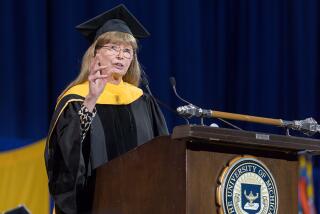Sematech Alliance Faces New Hurdle With Noyce’s Death
- Share via
From the beginning, life has been difficult for Sematech.
For starters, the charter of the ambitious 3-year-old government-and-industry consortium--to breathe new life into the domestic chip business by developing and dispersing state-of-the-art technology--is enormous. Even with Robert Noyce, the larger-than-life scientist and businessman, at its helm, the consortium endured criticism from within its own industry, and was the target of Bush Administration officials anxious to scale back projects smacking of an “industrial policy.”
Now, with Noyce’s death from a heart attack Sunday, Sematech faces an array of new challenges, not the least of which will be to persuade the federal government to continue, or even increase, its annual $100 million in contributions to the consortium after the initial funding expires in 2 1/2 years. Sematech’s 14 members contribute a total of more than $100 million each year, and lend the services of hundreds of scientists.
Even before Noyce’s death, success was far from assured. And without the charismatic leader, its prospects are less certain.
“The support for Sematech has been building in Congress,” said Rep. Mel Levine, (D-Santa Monica). “But without Bob Noyce, whose voice transcended politics, the bad guys in the Administration have one fewer adversary to deal with.”
A strong voice for cooperative efforts in the electronics industry was lost earlier this spring when Craig Fields, a high-ranking official in the Defense Department’s advanced research funding office, was forced to step aside amid Administration concerns that he was going too far in his advocacy of government assistance for the industry.
Noyce, co-inventor of the integrated circuit and co-founder of chip maker Intel Corp., reluctantly accepted Sematech’s top spot nearly two years ago after the consortium tried for months to find a willing and suitable leader. However, he always was the group’s top choice for the job, the one man industry leaders said could pull together the consortium’s 14 member companies and U.S. government into a unified research and manufacturing operation dedicated to jump-starting the sagging U.S. semiconductor industry.
But the job proved difficult in the beginning, even for Noyce.
Industry analysts said it took Sematech at least 18 months to develop a potentially winning strategy and then begin to execute it. The game plan, which came together in the last year, focuses the consortium’s efforts to shore up the nation’s “semiconductor infrastructure,” a loose-knit set of technologies and companies required to manufacture the state-of-the-art chips that are a part of a wide spectrum of consumer and industrial electronics.
Michael Borrus, from the Berkeley Roundtable on International Economics, said Sematech had to choose between two possible strategies early on. On the one hand, he said, they could take a short-term approach of improving the overall abilities of basic semiconductor manufacturing and its suppliers, or they could pursue a longer-term strategy of developing new technologies, gambling that they could steal a beat on the Japanese.
“They chose the short term on the theory that if they didn’t focus on that immediately, the long term wouldn’t matter,” Borrus said.
Over its first five years, Sematech’s goal is to develop the technological and manufacturing expertise to produce large quantities of semiconductors with circuit widths of 0.35 microns, or about 300 times finer than a human hair.
Sematech officials say they are on target for achieving that objective.
According to Borrus, Sematech’s most obvious accomplishment to date was its role in guiding the purchase of Perkin-Elmer’s optical lithography unit by a small Silicon Valley company, away from the Japanese camera giant, Nikon.
Noyce apparently sensed that the consortium was finally on an even keel operationally in April when he signalled his intention to step away from guiding daily operations by year-end to concentrate exclusively on lobbying the government and public on the group’s behalf.
In fact, Noyce had begun to search for his own replacement before he died. Sematech insiders said Noyce had already prepared a list of eight possible replacements and had started to talk to consortium members and others about the selection. Insiders said no front-runner has emerged.
However, three men are said to have expressed strong interest in the position before Noyce’s death: Sanford Kane, a former IBM executive who headed the unsuccessful effort last year to create U.S. Memories, a chip-making cooperative; Paul Castrucci, a former IBM executive and second-ranking Sematech official forced out last year by Noyce, and Larry W. Sumney, a former Pentagon official now heading the Semiconductor Research Corp. in North Carolina.
Not surprisingly, Sematech members have their own favorites. Among those mentioned as Noyce’s successor are: Gil Amelio, head of Rockwell International’s semiconductor operation; Gordon Moore, co-chairman of Intel; Andrew Grove, Intel’s chief executive, and Robert Galvin, the retired leader of Motorola Corp.
Sematech officials and members said a selection should be made within 60 days.






